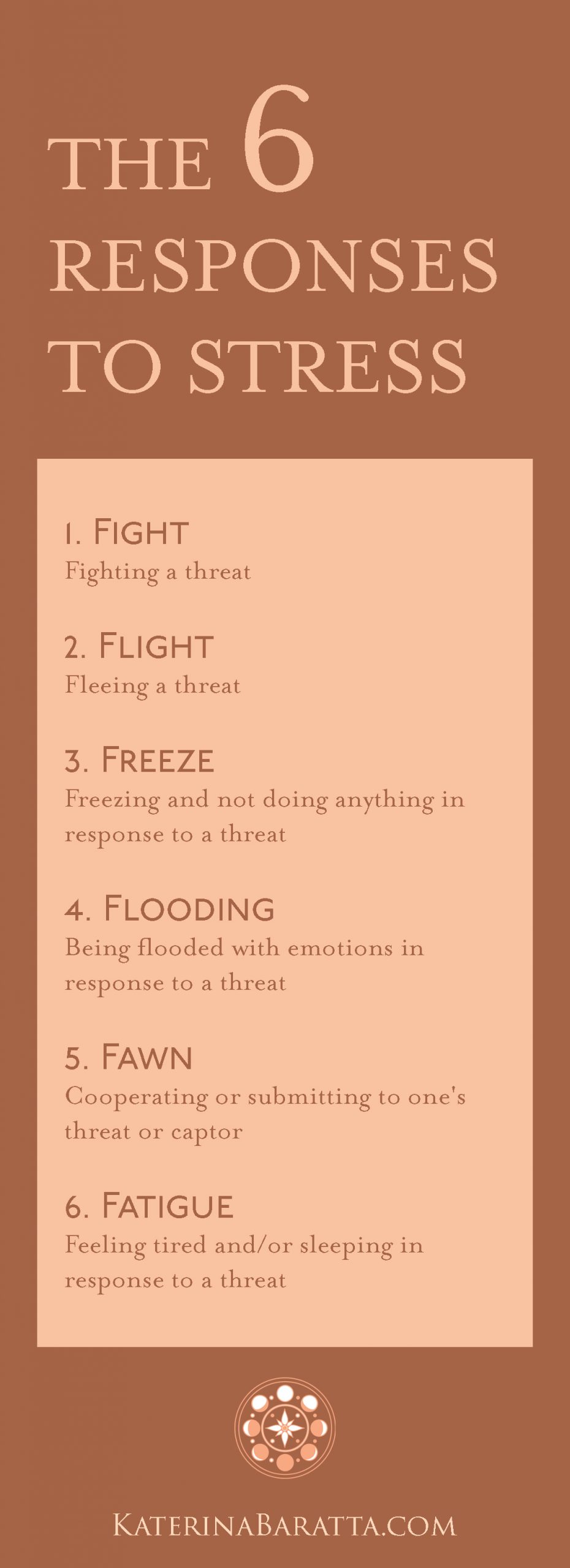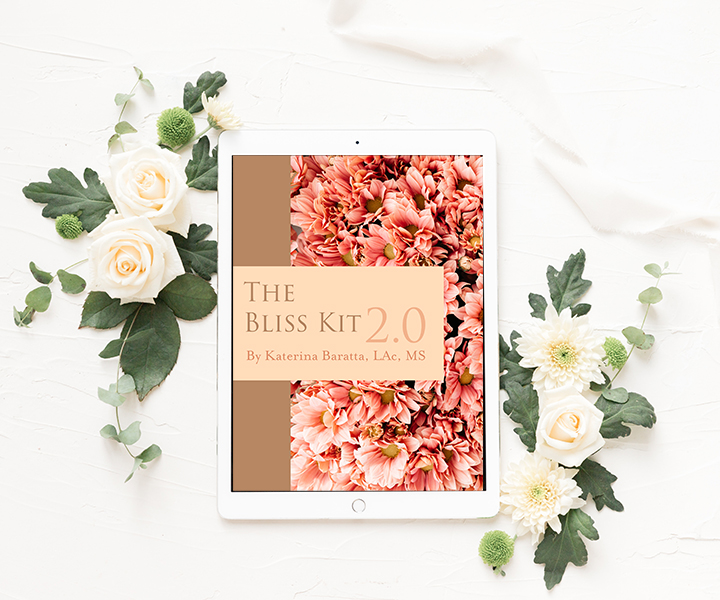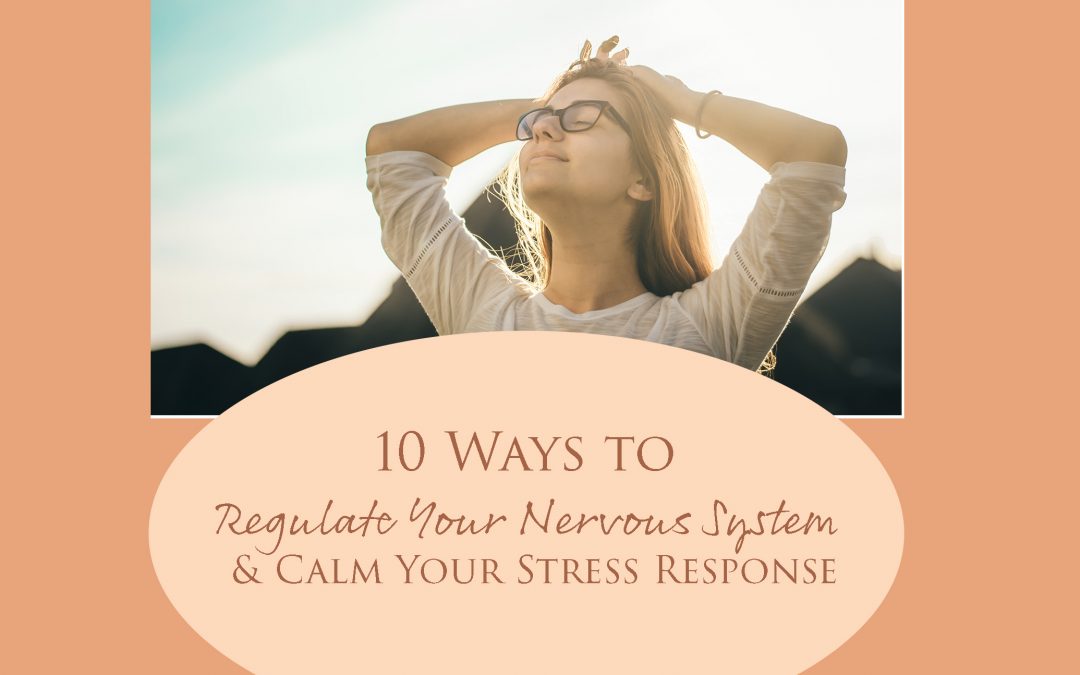10 Ways to Regulate Your Nervous System and Calm Your Stress Response
Stress is a natural part of life, but whether it harms you or not depends on how well you’re able to regulate your nervous system.
In this article:
The only way to stay calm in stressful situations is to regulate your nervous system.
Nervous system regulation makes a huge difference in how you feel and behave.
Without nervous system regulation, your emotions feel out of control. You’re reactive instead of responding to situations the way you want to. And to make matters worse, your body can send you all sorts of uncomfortable symptoms (like headaches, tummy trouble, brain fog, and more) in response.
Unless you learn how to regulate your nervous system, there isn’t much you can do about any of it.
Because when you get stressed, your sympathetic nervous system takes charge of your mind and body.
Your breathing gets quick and shallow.
You start to sweat.
Blood pressure increases as the blood in your body rushes out of your core organs and into your muscles.
Metabolism slows down as your body focuses entirely on what is needed for immediate survival. 1
But there are things you can do to help your nervous system calm down.
When you take these steps, your parasympathetic nervous system can more easily take the reigns again, so you feel clear headed and in control instead of reacting on autopilot.
There are 6 automatic reactions to stress: Fight, flight, freeze, flood, fawn, and fatigue.
You don’t have control over your initial response, but with practice, you can change what happens next.
Fight or flight is what most people have learned when they hear about natural stress responses.
And the typical example that’s given to explain these responses is what happens when a lion is chasing after you. You either fight the lion, or you run away from it.
But there are 4 other responses to stress that aren’t as well known. 2
The freeze response happens when you stop everything when you’re under threat.
This is what happens to squirrels who run into the road and stop in their tracks when they notice a car hurling at them at 50 mph.
It might seem counterproductive, but the freeze response happens when your system can’t find another way out of the situation, so it resorts to playing dead in hopes that the threat will just go away.
Pin This!

Another possibility is that you become totally overwhelmed by emotion.
This is called the flood response.
The fawn response is what happens when you cooperate or submit to a person who’s threatening you.
In a fawn situation, you put your own needs and desires in an attempt to avoid conflict.
Because when you were little, conflict with your caregivers could be a threat to your survival. If you are a people-pleaser and have trouble with boundaries, the fawn response is to blame.
Related: How to set boundaries with loved ones
Fatigue is the final way people respond to acute stressful situations.
This is similar to the freeze response. It happens most often to kids, who sometimes fall fast asleep in the middle of an extremely stressful situation, like a robbery or car accident, but it can also happen for adults and in response to chronic stress.
All of these responses originally evolved as ways to promote survival.
And they can still be useful when the situation is appropriate, but most of us aren’t constantly in life-threatening situations.
Despite our relative safety, though, stress levels are at an all-time high, so it’s more important than ever to learn how to turn down your stress response. 3
And the best way to turn down your stress response is to practice regulating your nervous system before you’re feeling stressed.
This allows you to build and strengthen neural connections that will make it easier for you to access your inner calm.
You can think of it as breaking your stress habit. In its place, you’re creating a new habit of feeling grounded, centered, and calm.
The more you practice regulating your nervous system outside of stressful situations, the easier it will be for you to access your inner calm even when you’re in the midst of an emotional storm.
But before we talk about how to regulate your nervous system, it’s helpful to understand what stress is, and where it’s coming from.
At the most surface level, stress is physical and emotional tension, and it shows up anytime something inside of you resist what’s happening in the present moment.
There are actually quite a few benefits to short bouts of stress (a.k.a. acute stress).
The stress hormone cortisol, for example, is what wakes you up in the morning. 4 Acute (short-term) stress also increases memory, alertness, and overall performance. 5
But this isn’t the type of stress we’re talking about here.
The type of stress we’re talking about is chronic stress —and it hurts.
It’s the type of stress that turns you into someone you don’t want to be. It’s the type of stress you wish would just go away.
The strategies in this article aren’t going to make your stress go away. As I already mentioned, stress is a natural part of life, and it’s not all bad.
But what I’m going to teach you here will help you regulate your nervous system so the stress is 1000x more manageable and doesn’t feel nearly as bad as it does now.
“Stress is caused by being here but wanting to be there,” -Eckhart Tolle
There are 3 places stress originates from: mind, body, and spirit.
In the mind, stress happens when you focus in the past or future instead of staying present with what is.
When you stay present, you’re able to see what you need to do in the moment. It is clear and happens spontaneously.
But when you focus on the past or future, you’re imagining reality instead of looking at it.
And you’re focused on things that you can’t control. Because in truth, you can never be in the past or future. You’re always here, now., and this is the only place in time that you can ever do anything.
Physical stress happens when the body is unable to do what it needs to do.
In Chinese medicine, it’s said that stress comes from a disruption in the flow of qi, or “life force/energy”.
Qi needs to flow calmly and smoothly for you to feel healthy in mind and body, but when qi is deficient, excessive, or stuck, you end up with uncomfortable symptoms.
For example, nutrient deficiencies force the body to draw on other resources to try to complete its tasks. This is stressful.
And since the mind and body are aspects of the same whole, when the body is stressed, you become emotionally stressed as well.
We can also see stagnation from stress happen in the nervous system.
When a stressful situation isn’t processed through the body, it gets stuck into your neurology and can lead to chronic stress. This is a form of trauma, which means that your body ends up activating a stress response all the time, even when there is no immediate threat.
Related: How to Release Trauma Trapped in Your Body
Finally, there’s spiritual stress.
Spiritual stress happens when you are too focused on what appears as physical reality and don’t tap into the deeper mystery that permeates everything.
Modern physics has proven that everything you take to be physical is actually just an interpretation of energy moving in time-space.
Any stability you perceive in physical reality is actually an illusion.
Just by observing your own life experience, you’ll quickly come to realize that everything you cling to eventually goes away. Everything that is born must die. Change is the only constant.
The physical realm has loss and instability built into it, and clinging to what can’t be clung to causes stress.
But when we go deeper and tap into the bigger picture, all of this coming and going is just like waves on the surface of the ocean.
Waves appear, shift, change, merge and then disappear again. All the while, the ocean is still the ocean.
Remembering this can shift your perspective so stress diminishes over time.
Here are 10 Ways to Regulate Your Nervous System so You Can Calm Your Stress Response
1. Slow and deepen your breath
It’s the first relaxation technique people learn, and with good reason.
Because remember what we said about your body’s stress response? When you’re stressed your breath gets quick and shallow.
And the interesting thing is that about 80% of the fibers in the vagus nerve —an essential part of the parasympathetic nervous system—run from the body to the brain. 6
So by consciously slowing and deepening your breath, you’re activating relaxation in your body which then tells your brain that you’re safe.
But while it seems like the most natural thing in the world, most people don’t actually know how to slow and deepen their breath.
Watch the video below to learn how to do it right.
It takes some practice.
And if you only try to do it when you’re already stressed, you’ll have a harder time getting this strategy to work for you.
If you practice it every day, on the other hand, you’ll be amazed at how beautifully you’re able to sail through the most stressful storms.
2. Cold exposure
In addition to breath work, “Iceman” Wim Hof has popularized ice baths and regular cold exposure for stress reduction and other health benefits. 7
The first time I heard of intentional cold exposure it didn’t make any sense to me.
It sounds really stressful, right? Who would intentionally want to make themselves uncomfortable?!
But that’s exactly the point.
When you regularly expose yourself to stressful situations (that aren’t actually life-threatening or harmful,) you train yourself to be able to handle other stressful situations that arise in life.
And cold exposure has an added benefit.
Once again, it’s all about the vagus nerve. When you put cold water on the sides of your neck, you activate the vagus nerve and help your body relax. 8
So the next time you feel stressed, try taking a cold shower or putting a cold rag on your neck and see what happens.
3. Mantra Repetition
Similar to an affirmation, a mantra is any sound, word, or phrase that you repeat to yourself.
Originally mantras were used in Buddhism, Hinduism, and Taoism as a way to train the mind to focus in meditation.
But they are also really powerful in helping your brain make favorable neural connections that reduce stress.
In the case of traditional mantras specifically, you’re usually repeating words in an ancient language. It’s said that those words are infused with a specific sort of energy that you then align yourself and your awareness with.
So when you repeat your mantra, you drop into a calmer zone.
But this isn’t as woo-woo as it sounds.
There’s good evidence that mantra repetition can really help to reduce stress. 9
Pin This!

Affirmations are a type of mantra.
They’re phrases in your native language, that you repeat in order to shift your thought patterns to something more positive, and they can be a powerful way to reduce stressful thoughts.
But if you use an affirmation as a mantra, there’s a hitch.
You’ve got to believe the words you’re saying.
If you repeat an affirmation like “I am beautiful,” or “I am happy, I am strong, I am powerful,” fore example, but don’t believe what you’re saying, then you end up having the opposite effect. 10
Because you know when you’re lying to yourself.
So instead of strengthening the neural connections that you’re going after, you end up strengthening the neural connections that are related to self-betrayal, mistrust, and discord.
True positivity doesn’t come trying to trick yourself into being positive.
It comes from looking honestly at what is, and meeting whatever you find with openness instead of labels. And this includes stressful situations.
Related: Mindset Shifting Mantras to Relieve Stress and Anxiety
4. Present awareness
Also called mindfulness, present awareness means turning your attention to the present moment. Because unless you’re in immediate danger, the stress you’re experiencing invariably comes from your focus on the past or the future.
Makes sense, right?
So a great way to regulate your nervous system and reduce stress is to hone in on what’s happening right here, right now.
Some people do this by noticing their breath. Others have a color they choose to focus on, and in a moment of intense stress they might look around to count all the things they can spot in that color.
You can also practice witnessing the feeling of aliveness in your body, or focus on the experience of washing dishes, without labeling what’s happening.
Thoughts will always come in.
The practice is to notice them arising, and then let them go, without engaging in the story that they tell you.
At first you’ll feel like this is impossible.
You might even feel like the chatter in your mind gets louder when you try to quiet it, and you can’t help but get swept up in the stories your thoughts are telling you. But in reality you’re just becoming aware of the chatter that’s going on in your head all the time.
And it’s perfectly normal. It’s the nature of the mind, and you’ll notice it shifting over time.
The practice of present awareness helps you train your mind so the stressful chatter doesn’t entirely go away, but it becomes less important to you.
And when your thoughts become less important to you, your nervous system regulates more easily so you feel less stressed.
The best part is, you don’t have to sit quietly on a meditation cushion to practice present awareness.
There are SO many opportunities to practice this every day.
Related: Learn how to use mealtimes as a mindfulness practice.
5. Inquiry
Another way to stop taking your thoughts so seriously is through inquiry.
Inquiry requires an initial awareness and willingness to look at the thoughts that are stressing you out.
And in the beginning, a lot of people avoid this practice because they don’t want to feel the feelings that are associated with those thoughts.
But trust me, it hurts a hellofalot more to stuff those thoughts and feelings down than to pull them out and discover the truth inside of them.
You’re not looking because you’re afraid of what you’ll find.
But when you shine a light on the shadows of your psyche, I promise that you’ll discover that they were never as scary as you thought they were.
And the amazing thing is, through inquiry you start to realize that your thoughts aren’t even true. Or at least they’re never telling you the whole truth.
When you practice inquiry long enough, eventually you’ll be able to question your thoughts the moment they arise, and this is truly life-changing.
It’s a fast path to emotional freedom.
Because with inquiry you’re no longer at the mercy of your past conditioning.
Instead, you’re able to embrace each moment for what it is, respond appropriately, and stop stressing about any of it.
The two teachers that have helped me the most on the path of inquiry are Byron Katie with what she calls The Work, and Lester Levenson with the Sedona Method.
I teach some powerful inquiry techniques in my online course, Healing Through Anxiety, plus other strategies that help you heal the root causes of stress and anxiety. Learn more here.
6. Grounding and nature
Grounding, or coming in direct-skin contact with the earth, has been shown to change your body’s electrical charge and have a measurable effect on cortisol levels. 11
But while there are incredible physiological changes that happen when you spend time with your hands and feet in the earth, you don’t even have to touch soil to reap the mental health benefits of nature. 12
A 2009 multi-study analysis published by the Interdisciplinary Centre for Environment and Society at the University of Essex found that exercising in the presence of nature has a positive effect on mental health in both the long and short-term. 13
And before you think it’s just the exercise that’s lifting people’s moods, hear this:
A 2012 randomized controlled trial published in the European Journal of Applied Physiology showed that just looking at pictures of nature significantly increased stress-busting parasympathetic activity. 14
So if you can spend some time forest bathing like the Japanese do, excellent. 15
But if all you’ve got in a moment of stress is a picture of a flower, focus on that. It’ll help you regulate your nervous system too.
7. Qigong
Qigong is basically Chinese yoga. The direct translation means “working with life force energy”.
You’ve probably seen elderly people practicing Taichi in the park. This is a form of qigong, but don’t be deceived by the slow pace.
Qigong is a powerful practice that can literally change your life.
Because it teaches you to move blocked energy through your body, and that’s all stress is: Energy that wants to move but is being blocked.
One of the most powerful qigong techniques for regulating the nervous system and releasing stress is through shaking.
It looks and sounds a little weird at first, but once you feel the effects your body will start to crave it, especially when you’re feeling stressed.
Click here to watch a video that will show you how.
Another great technique is Universe Stance, which has the added benefit of grounding.
This is technique is basically a standing meditation, and with practice, your body will naturally shed layers of stress just by moving your body into the stance.
8. Trauma release exercises (TRE®)
Trauma release exercises are similar to qigong in that they use shaking.
But instead of jumping and actively shaking out your body, as you do in qigong, in the case of trauma release exercises you’re intentionally causing muscular tension in your body so tremors can arise on their own.
It’s a lot like when you’re working out and your muscles start to shake.
But when you’re doing TRE you let your body continue shaking so the stress that’s lodged in your body can move out.
As with all of these nervous system regulating strategies, you’re going to get the most benefit by practicing TRE regularly.
I teach a version of this (and how to set your life up so you actually show up to practice instead of self-sabotaging) in my online course, Healing Through Anxiety.
9. Herbal medicine
Medicinal herbs have been around way longer than modern pharmaceuticals, and they’ve been used for thousands of years to regulate the nervous system —long before anyone had any idea what the nervous system even was!
Herbs like ashwaghanda, holy basil, and rhodiola, for example, are called adaptogenic herbs. These have a direct effect on your adrenal glands, which produce hormones that help you regulate your stress response. 16
But don’t click over to Amazon and buy these herbs just yet, because they’re not right for everyone.
All herbal products aren’t created equal.
Click here to download your free copy of the Best Herbs for Anxiety PDF and learn which herbs might be right for you.
10. Acupressure
And finally, acupressure is another powerful strategy to regulate your nervous system.
The most effective way to use acupressure is to have a set of points prescribed to you by a licensed practitioner.
But the one point I recommend to almost everyone I work with is called Pericardium 6 (PC6).
It’s 3 finger widths proximal from the wrist-crease (so up the inside of your forearm, moving closer to your body from your hand.)
And you’ll find it between the tendons on the inside of your wrist.
If you’ve ever used those armbands for nausea or morning sickness, you’re targeting the same point.
Here’s a picture so you know exactly where to press.
You can use PC6 both as a preventative measure and in the midst of a stressful situation. Simply press down into the point for a few minutes, release, and repeat on the other side.

Want to learn more?
The (free) Bliss Kit PDF will walk you through a powerful 4 step process to rewire your neurology for more ease, joy, and inner peace.
References:
1. https://pubmed.ncbi.nlm.nih.gov/18370704/
2. https://www.dailymail.co.uk/sciencetech/article-4690778/Researchers-reveal-SIX-responses-stress.html
3. https://www.apa.org/news/press/releases/stress/2020/report-october
4. https://www.urmc.rochester.edu/encyclopedia/content.aspx?contenttypeid=167&contentid=cortisol_serum
5. https://news.berkeley.edu/2013/04/16/researchers-find-out-why-some-stress-is-good-for-you/
6. https://www.physio-pedia.com/Vagus_Nerve
7. https://www.wimhofmethod.com/cold-therapy
8. https://www.ncbi.nlm.nih.gov/pmc/articles/PMC6334714/
9. https://www.sciencedirect.com/science/article/pii/S1876382018304591
10. https://www.uni-muenster.de/imperia/md/content/psyifp/aeechterhoff/wintersemester2011-12/seminarthemenfelderdersozialpsychologie/04_wood_etal_selfstatements_psychscience2009.pdf
11. https://www.ncbi.nlm.nih.gov/pmc/articles/PMC3265077/
12. https://www.ncbi.nlm.nih.gov/pmc/articles/PMC4378297/
13. http://coping.us/images/What_is_the_Best_Dose_of_Nature_and_Green_Exercise_for_Improving_Mental_Health_-Barton_Pretty_2010_.pdf
14. https://pubmed.ncbi.nlm.nih.gov/22270487/
15. https://www.ncbi.nlm.nih.gov/pmc/articles/PMC5580555/
16. https://www.hopkinsmedicine.org/health/conditions-and-diseases/adrenal-glands




